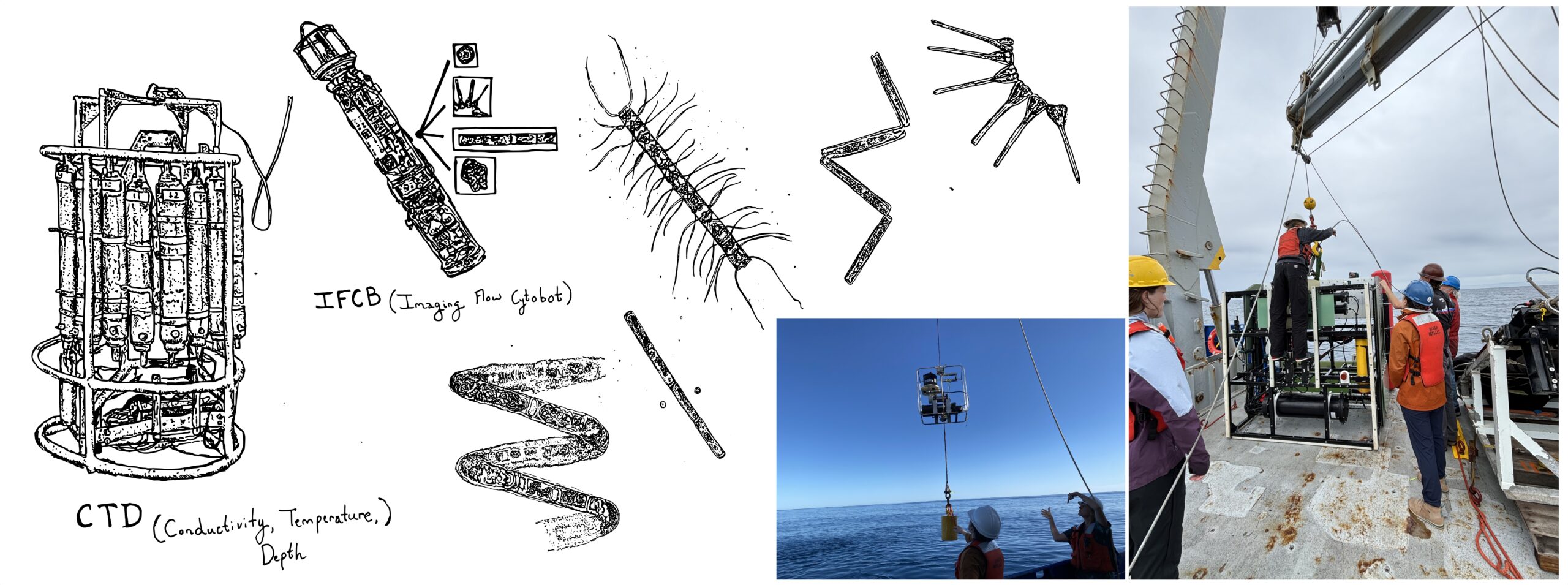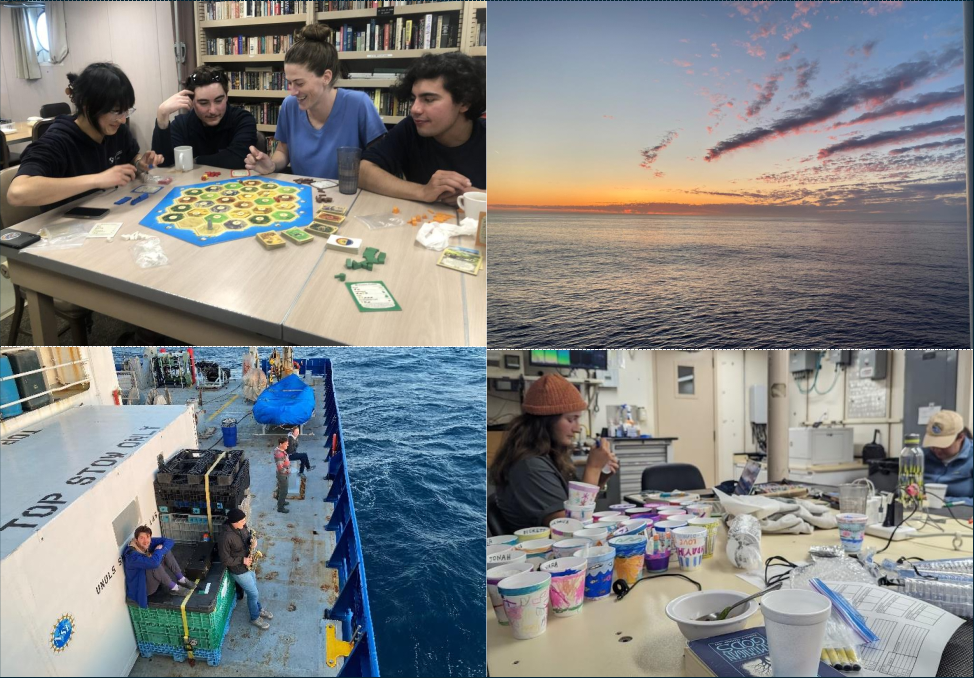Scientists study the effects of marine heatwaves and climate change aboard the R/V Revelle in the California Current Ecosystem.
by Dante Capone, graduate student at the CCE LTER and the Scripps Institute of Oceanography
All Aboard for Phase IV of the California Current Ecosystem LTER!
You awaken from the rhythmic roll of the long period swell to a jarring crash as a wave strikes the hull of the boat. Pulling back the black out curtains on the top bunk in your cozy cabin you share with a fellow scientist, you carefully descend the ladder to the shifting floor and slide into your wet weather gear. Climbing a few flights of narrow stairs, and you arrive for a brief pitstop in the galley to fill a cup of the perpetually brewing coffee that keeps the crew functioning. Descending, you enter the massive, shared lab of the R/V Revelle, where you join the research team gathered in anticipation of the next bout of oceanographic sampling. Welcome aboard the most recent cruise of the California Current Ecosystem LTER (CCE-LTER)!

Credit: SIO Ship Operations
For 5 weeks from February to March 2024, a crew of professors, researchers, technicians, graduate students, and volunteers conducted science off the coast of California to understand how emerging stressors such as marine heatwaves, changing nutrient supplies and altered predation pressures impact the pelagic upwelling ecosystem. They tracked and sampled different water masses off the coast while conducting experiments to alter temperature and nutrient supply to the natural microbial and plankton communities.
This is the first cruise in the CCE LTER site’s Phase IV of research questions, which builds off exploration of past topics such as upwelling, the transport of nutrients and organisms offshore, and the impacts of El Nino. Representatives from many institutions including Scripps Institution of Oceanography, University of Alaska, Rice University, Florida State University, and more assemble in San Diego days prior to departure to load their equipment and build lab spaces on the boat they’ll need for the month ahead.
The CTD: a nexus of collaboration and data
Once at sea, research aboard the RV Revelle is conducted in ‘Lagrangian Cycles’ of 3-5 days which involve following a water ‘parcel’ as it changes through time. A Cycle begins when the scientists locate an interesting portion of ocean, take measurements of the biogeochemistry, then deploy drifting arrays bearing both sediment traps to measure carbon export and experiments with altered properties of the water.
As the Revelle pursues the drift array, researchers employ the CTD rosette (Conductivity, Temperature, Depth)—a cornerstone of oceanographic research which collects water from different depths. The CTD is loaded with sensors that measure everything from temperature and pH to the amount of phytoplankton and particles in the water. During a Cycle the CTD is dropped into the water at 2 AM, 6AM, 12PM, and 6PM, overseen by a diverse team of molecular biologists and chemists. Each CTD cast reveals details about the vertical structure of the physical and chemical environment and collects seawater from select depths using remotely controlled Niskin bottles.
The team collectively pours liters of water through tiny quartz filters that concentrate the carbon, nitrogen, and phosphorus in seawater They also collect water straight into various vessels to later measure biological products including DNA, RNA, or metabolites, and important ecosystem metrics such as net primary productivity. While many lab groups specialize in a single aspect of the environment, the team works together to prioritize time sensitive sampling like the activity of microbes, which facilitates a natural exchange of curiosity and knowledge between researchers.
Other equipment aids the collection of complementary data to the CTD’s water and sensors. To explore the connections between the surface and the seafloor facilitated by sinking matter, scientists use McLane pumps to pump liters of particles and biological eDNA traces onto filters. These filters allow researchers to measure phytoplankton that form the base of marine productivity,but researchers also study phytoplankton in finer detail through images using an Imaging Flow Cytobot. This instrument sips seawater pumped through the ship, uses lasers to detect fluorescent particles and plankton and snaps a picture which can later be classified using machine learning.
Alongside the monitoring and data collection gathered by instruments, what sets the CCE-LTER apart is the effort scientists put into directly testing hypotheses and mechanisms underlying the ecosystem. Experiments conducted in bottles placed both on the drift array (to simulate natural depth conditions and flow) and in specially designed incubators on deck allow scientists meticulously determine how projected changes in nutrients, temperature, or other conditions affect the suite of measurements the team collects from the ambient water. Experiments can be highly collaborative; they may be pre-planned or born from a hypothesis that emerges from conversation over the CTD. These experiments are a keystone of the CCE-LTER’s feedback cycle of curiosity and knowledge generation: “observe, experiment, model”.

Credit: Photo by Jamee Adams and Marco Moriel. Illustrations by Dante Capone.
Catch those drifters: sampling the plankton
Teamwork is crucial for all science on board, but members in charge of the zooplankton operations know that it takes a village of volunteers to collect their valuable biological measurements. They have a day team (7AM-7PM) and a night team (7PM-7AM). The night team is compensated for converting to a nocturnal lifestyle for the month with a greater diversity and abundance of plankton which aggregate at the surface during their diel vertical migration. This is a process during which plankton move from the depths beyond which light penetrates up to the surface, a commute that would be the same as a human running 10 km to and from your daily job.
In previous cruises, blooms of gelatinous zooplankton such as sea pickles, or pyrosomes, have overwhelmed the nets. These gelatinous plankton occur in boom-bust cycles and researchers at the CCE-LTER are working to understand how an anomalous recent rise of ‘gelata’ associated with warming might impact the ecosystem in the future. During P2402, pyrosomes dominated one cycle, but were mysteriously absent from others—leaving the researchers to piece together the story back on land.
The zooplankton team are equipped with an arsenal of nets and instruments to study the tiny drifters. The Bongo net looks like a bongo drum, with a pair of nets for replicate sampling. The Manta net skims the neuston, or ocean’s surface, its mouth agape, collecting the unique community of organisms and debris that reside in the air-sea interface. The Multiple Opening and Closing Net and Environmental Sensing System (MOCNESS) is a beast of a net, comprised of 10 distinct nets for sampling different depths and equipped with the same suite of sensors as the CTD. Finally, scientists collaborating from the Northern Gulf of Alaska LTER have brought the Deep Plankton Imager (DPI) which images plankton in the water, capturing their natural form. The measurements of plankton through net collected specimens, DNA, and images collectively paint a more detailed understanding of the plankton community.
Zooplankton from the nets are divided up using a specially designed plastic wheel called a Folsom splitter. The different portions will be analyzed for measurements such as biomass, species composition, stomach contents, and stable isotopes. A jar of formaldehyde-preserved plankton is always taken to be archived in the Pelagic Invertebrate Collection at Scripps—essentially a plankton library dating back over 100 years! On top of the plankton role alongside the physical and biogeochemical measurements to piece together the observed ecosystem state, additional plankton may be collected for the experiments to explore questions such as how much fecal pellets are contributing to carbon export or nutrient supply.

Credit: Marco Moriel, Caro Buck, Hannah Kepner & Russ Hopcroft
From physics to biology: a connected ocean
From physical properties like temperature to chemical molecules, to organisms like plankton, each measurement uncovers a new piece of the interconnected ocean system. Temperature, salinity, and other physical properties characterize a water mass and allow scientists to place their sampling in context. Nutrients can provide insight into the history of a water mass–is it upwelled and ripe with nitrogen and iron from the deep, or is it depleted in some key ingredient and thus limiting the growth of organisms within it? For Phase IV of the CCE, scientists seek to understand how changes in the availability of different nutrients relative to one another, termed ‘ecological stoichiometry,’ impact biology.
During this cruise, the science team explores a key emerging disturbance in the CCE: marine heatwaves. Recent marine heatwaves in 2014-2015 and 2019-2020 altered ambient physical and chemical conditions, physiology, and modify organisms’ normal ranges. During a heatwave, the surface ocean is warmer, the vertical structure more stratified, and the supply of deep nutrients becomes limited. Heatwaves in the CCE may favor tropical over temperate organisms, which can restructure the community. Increased temperatures can also increase processes like growth and respiration, which in turn alter the nutrients and chemical state of the ocean. Aboard the vessel the researchers tackle some of these projected changes and utilize specially designed equipment to conduct parallel studies of the present conditions and a modified +2°C to understand how the system might shift during the next extreme event.
More than science-what are the unique challenges and nuances of life at sea?
Beyond the science, the second clock that the residents on the vessel live by is the unwavering mealtime windows: breakfast is 7:30-8:15, lunch is 11:30-12:15, dinner is 5:00-6:00. Ensuring that you are well fueled is critical to working through long shifts, which can be both mentally and physically demanding. On top of that, mealtimes are an opportunity for mingling between the many groups on board: exchanging stories and laughs of life on land, or troubleshooting the pressing difficulties of the latest instrument breaking down. The galley is connected to a lounge, so both scientists and crew alike often socialize through games such as cribbage, poker, or Catan while enjoying their meal.

Credit: Caro Buck and Jamee Adams.
Although the CCE-LTER has been undertaking sampling campaigns since 2004, each voyage comes with a new set of challenges. During the cruise, the science team faced unique constraints that superseded even the scientific schedule. The region where the team had planned to conduct their experiments coincided with U.S. Navy operations that restricted outsider activity. Outside the naval activity, buffeting winds and large winter swells further disrupted normal deployments. Despite this, the team was able to adapt, completing 5 Cycles, replicating experiments, and sampling different conditions.
In the small, fluctuating windows between science, meals, and unpredictable setbacks, the team fills their time with their favorite leisure activities. For some this is sweating it out in the gym aboard the ship, for others it may be finding a quiet nook to read a book, crocheting, or even simply ritualistically gazing off the bow to catch each sunrise and sunset over the endless horizon. As the cruise passes, time is distorted: the weeks since touching land feel like an eternity, but the days and shifts flash by, only marked by the increasing numerals as samples are recorded. Being a participant on an oceanographic cruise teaches you to go with the flow—the ocean’s rhythm governs above all else. From the veteran trace metal chemist to the green zooplankton team volunteer, each participant tunes in to their own melody to cope with the ever-changing ocean. Collectively, they harmonize to contribute to the important research at this LTER.










